SWOT and PESTLE Analysis of Unilever
VerifiedAdded on 2020/06/04
|17
|5127
|496
AI Summary
This assignment delves into the complexities of analyzing a global corporation's business environment. Focusing on Unilever, it utilizes both SWOT (Strengths, Weaknesses, Opportunities, Threats) and PESTLE (Political, Economic, Social, Technological, Legal, Environmental) frameworks to evaluate internal capabilities and external macro-factors influencing the company's operations. The analysis explores Unilever's competitive advantage, potential risks, and strategies for navigating a dynamic market landscape.
Contribute Materials
Your contribution can guide someone’s learning journey. Share your
documents today.
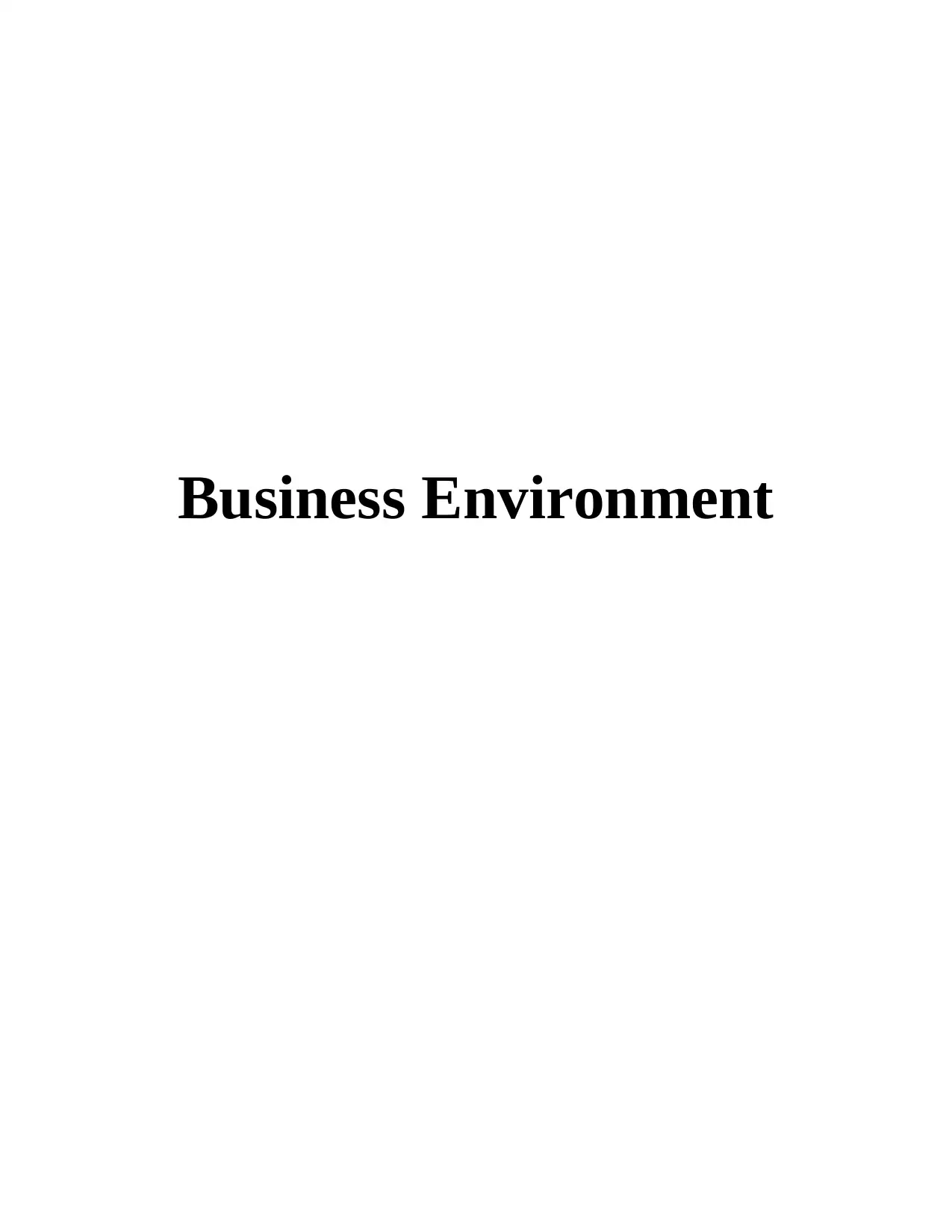
Business Environment
Secure Best Marks with AI Grader
Need help grading? Try our AI Grader for instant feedback on your assignments.
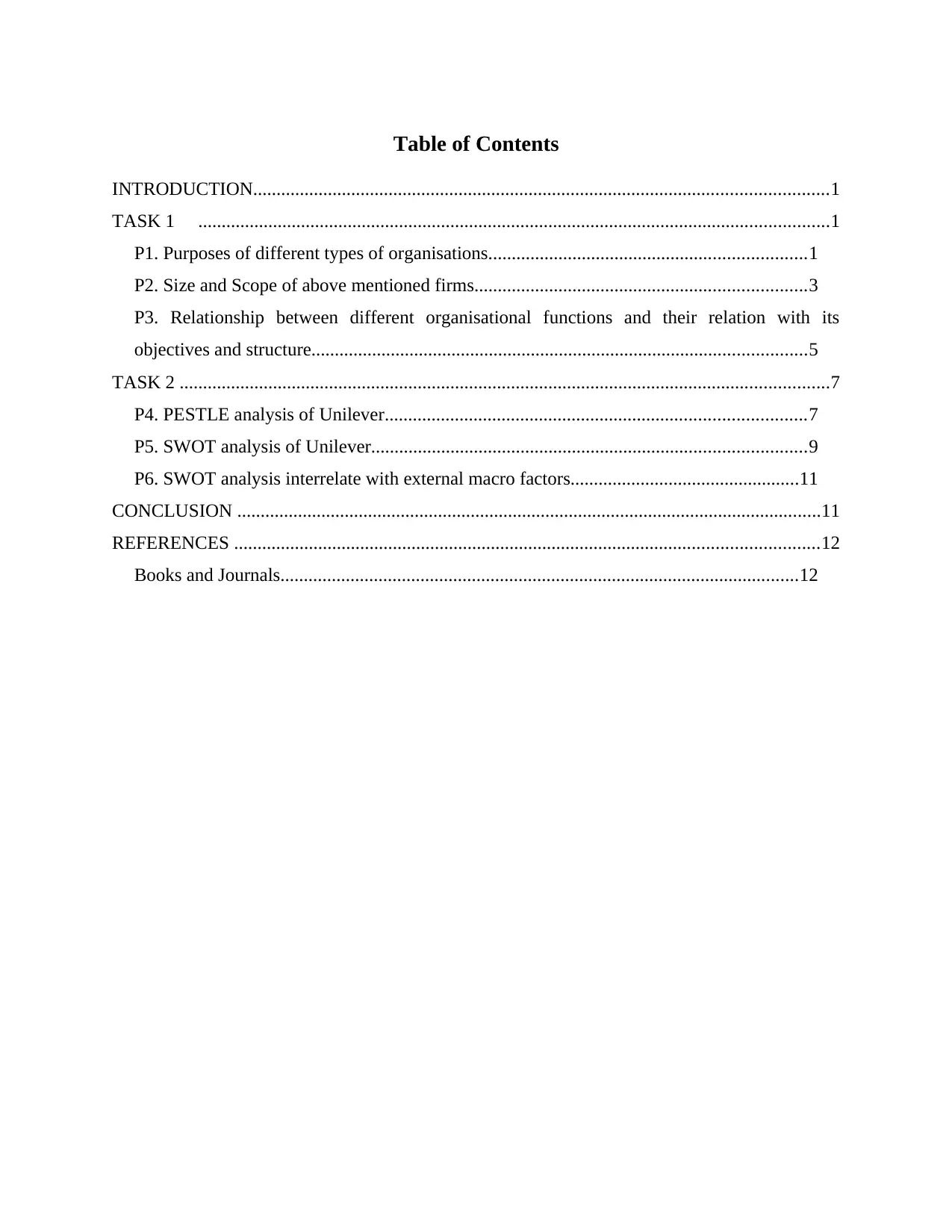
Table of Contents
INTRODUCTION...........................................................................................................................1
TASK 1 .......................................................................................................................................1
P1. Purposes of different types of organisations....................................................................1
P2. Size and Scope of above mentioned firms.......................................................................3
P3. Relationship between different organisational functions and their relation with its
objectives and structure..........................................................................................................5
TASK 2 ...........................................................................................................................................7
P4. PESTLE analysis of Unilever..........................................................................................7
P5. SWOT analysis of Unilever.............................................................................................9
P6. SWOT analysis interrelate with external macro factors.................................................11
CONCLUSION .............................................................................................................................11
REFERENCES .............................................................................................................................12
Books and Journals...............................................................................................................12
INTRODUCTION...........................................................................................................................1
TASK 1 .......................................................................................................................................1
P1. Purposes of different types of organisations....................................................................1
P2. Size and Scope of above mentioned firms.......................................................................3
P3. Relationship between different organisational functions and their relation with its
objectives and structure..........................................................................................................5
TASK 2 ...........................................................................................................................................7
P4. PESTLE analysis of Unilever..........................................................................................7
P5. SWOT analysis of Unilever.............................................................................................9
P6. SWOT analysis interrelate with external macro factors.................................................11
CONCLUSION .............................................................................................................................11
REFERENCES .............................................................................................................................12
Books and Journals...............................................................................................................12
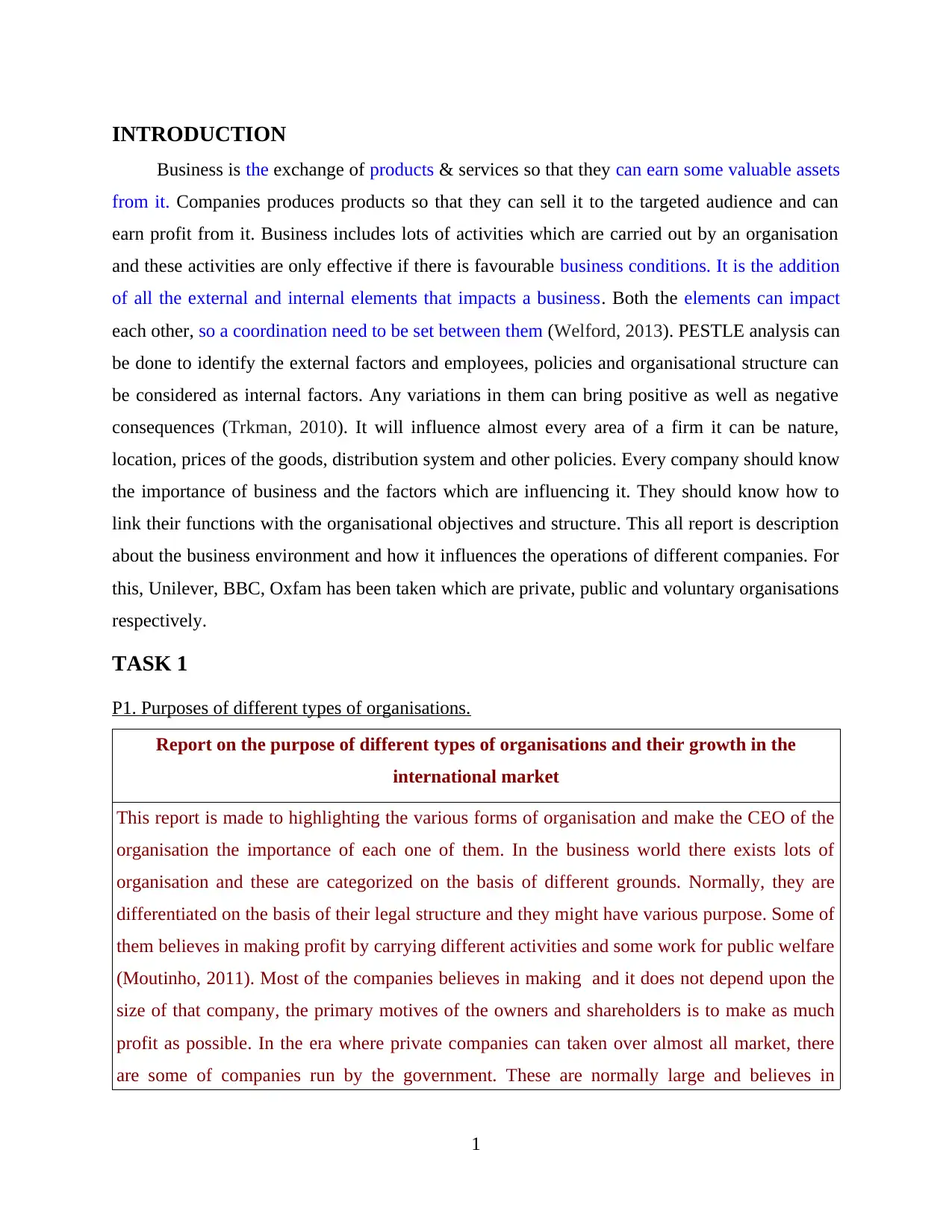
INTRODUCTION
Business is the exchange of products & services so that they can earn some valuable assets
from it. Companies produces products so that they can sell it to the targeted audience and can
earn profit from it. Business includes lots of activities which are carried out by an organisation
and these activities are only effective if there is favourable business conditions. It is the addition
of all the external and internal elements that impacts a business. Both the elements can impact
each other, so a coordination need to be set between them (Welford, 2013). PESTLE analysis can
be done to identify the external factors and employees, policies and organisational structure can
be considered as internal factors. Any variations in them can bring positive as well as negative
consequences (Trkman, 2010). It will influence almost every area of a firm it can be nature,
location, prices of the goods, distribution system and other policies. Every company should know
the importance of business and the factors which are influencing it. They should know how to
link their functions with the organisational objectives and structure. This all report is description
about the business environment and how it influences the operations of different companies. For
this, Unilever, BBC, Oxfam has been taken which are private, public and voluntary organisations
respectively.
TASK 1
P1. Purposes of different types of organisations.
Report on the purpose of different types of organisations and their growth in the
international market
This report is made to highlighting the various forms of organisation and make the CEO of the
organisation the importance of each one of them. In the business world there exists lots of
organisation and these are categorized on the basis of different grounds. Normally, they are
differentiated on the basis of their legal structure and they might have various purpose. Some of
them believes in making profit by carrying different activities and some work for public welfare
(Moutinho, 2011). Most of the companies believes in making and it does not depend upon the
size of that company, the primary motives of the owners and shareholders is to make as much
profit as possible. In the era where private companies can taken over almost all market, there
are some of companies run by the government. These are normally large and believes in
1
Business is the exchange of products & services so that they can earn some valuable assets
from it. Companies produces products so that they can sell it to the targeted audience and can
earn profit from it. Business includes lots of activities which are carried out by an organisation
and these activities are only effective if there is favourable business conditions. It is the addition
of all the external and internal elements that impacts a business. Both the elements can impact
each other, so a coordination need to be set between them (Welford, 2013). PESTLE analysis can
be done to identify the external factors and employees, policies and organisational structure can
be considered as internal factors. Any variations in them can bring positive as well as negative
consequences (Trkman, 2010). It will influence almost every area of a firm it can be nature,
location, prices of the goods, distribution system and other policies. Every company should know
the importance of business and the factors which are influencing it. They should know how to
link their functions with the organisational objectives and structure. This all report is description
about the business environment and how it influences the operations of different companies. For
this, Unilever, BBC, Oxfam has been taken which are private, public and voluntary organisations
respectively.
TASK 1
P1. Purposes of different types of organisations.
Report on the purpose of different types of organisations and their growth in the
international market
This report is made to highlighting the various forms of organisation and make the CEO of the
organisation the importance of each one of them. In the business world there exists lots of
organisation and these are categorized on the basis of different grounds. Normally, they are
differentiated on the basis of their legal structure and they might have various purpose. Some of
them believes in making profit by carrying different activities and some work for public welfare
(Moutinho, 2011). Most of the companies believes in making and it does not depend upon the
size of that company, the primary motives of the owners and shareholders is to make as much
profit as possible. In the era where private companies can taken over almost all market, there
are some of companies run by the government. These are normally large and believes in
1
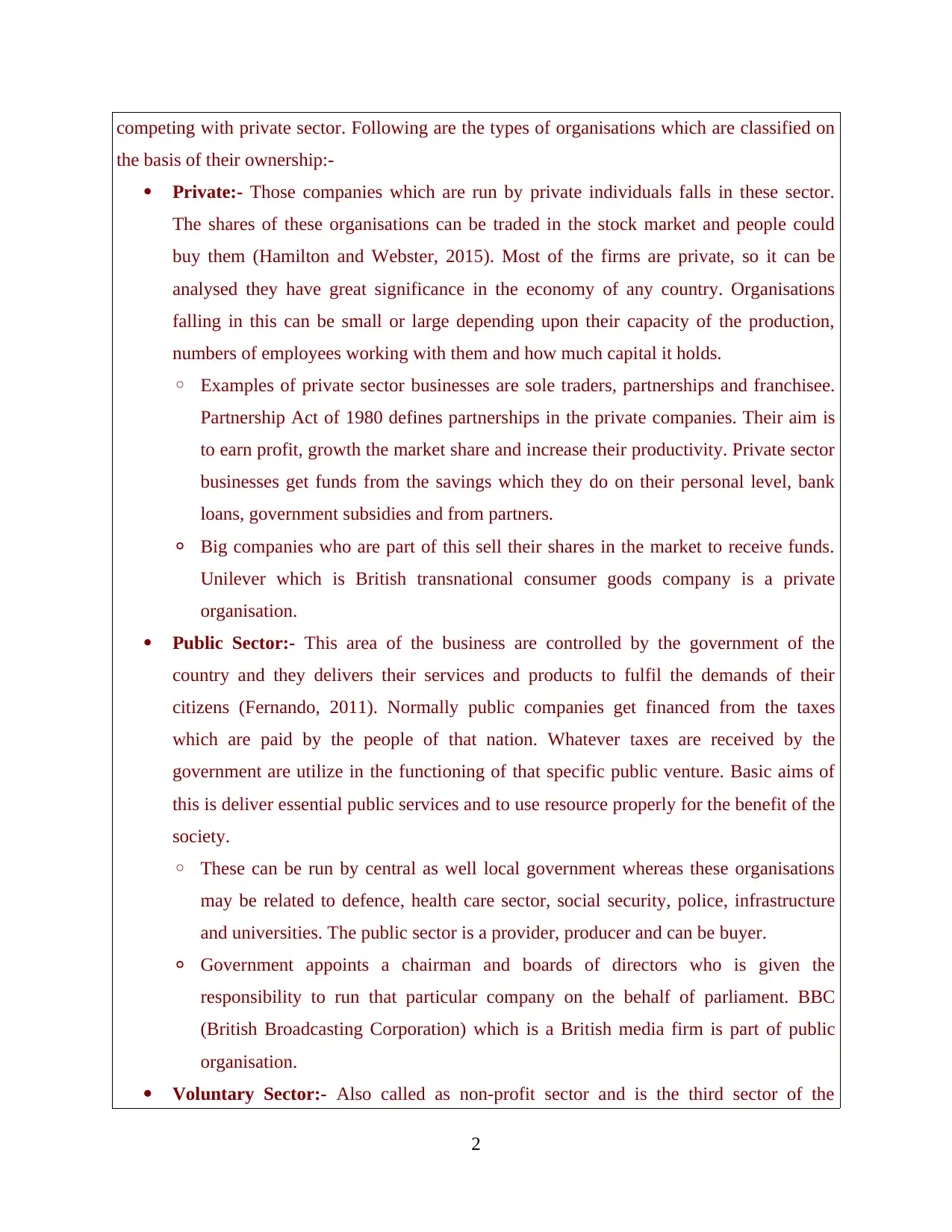
competing with private sector. Following are the types of organisations which are classified on
the basis of their ownership:-
Private:- Those companies which are run by private individuals falls in these sector.
The shares of these organisations can be traded in the stock market and people could
buy them (Hamilton and Webster, 2015). Most of the firms are private, so it can be
analysed they have great significance in the economy of any country. Organisations
falling in this can be small or large depending upon their capacity of the production,
numbers of employees working with them and how much capital it holds.
◦ Examples of private sector businesses are sole traders, partnerships and franchisee.
Partnership Act of 1980 defines partnerships in the private companies. Their aim is
to earn profit, growth the market share and increase their productivity. Private sector
businesses get funds from the savings which they do on their personal level, bank
loans, government subsidies and from partners.
◦ Big companies who are part of this sell their shares in the market to receive funds.
Unilever which is British transnational consumer goods company is a private
organisation.
Public Sector:- This area of the business are controlled by the government of the
country and they delivers their services and products to fulfil the demands of their
citizens (Fernando, 2011). Normally public companies get financed from the taxes
which are paid by the people of that nation. Whatever taxes are received by the
government are utilize in the functioning of that specific public venture. Basic aims of
this is deliver essential public services and to use resource properly for the benefit of the
society.
◦ These can be run by central as well local government whereas these organisations
may be related to defence, health care sector, social security, police, infrastructure
and universities. The public sector is a provider, producer and can be buyer.
◦ Government appoints a chairman and boards of directors who is given the
responsibility to run that particular company on the behalf of parliament. BBC
(British Broadcasting Corporation) which is a British media firm is part of public
organisation.
Voluntary Sector:- Also called as non-profit sector and is the third sector of the
2
the basis of their ownership:-
Private:- Those companies which are run by private individuals falls in these sector.
The shares of these organisations can be traded in the stock market and people could
buy them (Hamilton and Webster, 2015). Most of the firms are private, so it can be
analysed they have great significance in the economy of any country. Organisations
falling in this can be small or large depending upon their capacity of the production,
numbers of employees working with them and how much capital it holds.
◦ Examples of private sector businesses are sole traders, partnerships and franchisee.
Partnership Act of 1980 defines partnerships in the private companies. Their aim is
to earn profit, growth the market share and increase their productivity. Private sector
businesses get funds from the savings which they do on their personal level, bank
loans, government subsidies and from partners.
◦ Big companies who are part of this sell their shares in the market to receive funds.
Unilever which is British transnational consumer goods company is a private
organisation.
Public Sector:- This area of the business are controlled by the government of the
country and they delivers their services and products to fulfil the demands of their
citizens (Fernando, 2011). Normally public companies get financed from the taxes
which are paid by the people of that nation. Whatever taxes are received by the
government are utilize in the functioning of that specific public venture. Basic aims of
this is deliver essential public services and to use resource properly for the benefit of the
society.
◦ These can be run by central as well local government whereas these organisations
may be related to defence, health care sector, social security, police, infrastructure
and universities. The public sector is a provider, producer and can be buyer.
◦ Government appoints a chairman and boards of directors who is given the
responsibility to run that particular company on the behalf of parliament. BBC
(British Broadcasting Corporation) which is a British media firm is part of public
organisation.
Voluntary Sector:- Also called as non-profit sector and is the third sector of the
2
Secure Best Marks with AI Grader
Need help grading? Try our AI Grader for instant feedback on your assignments.
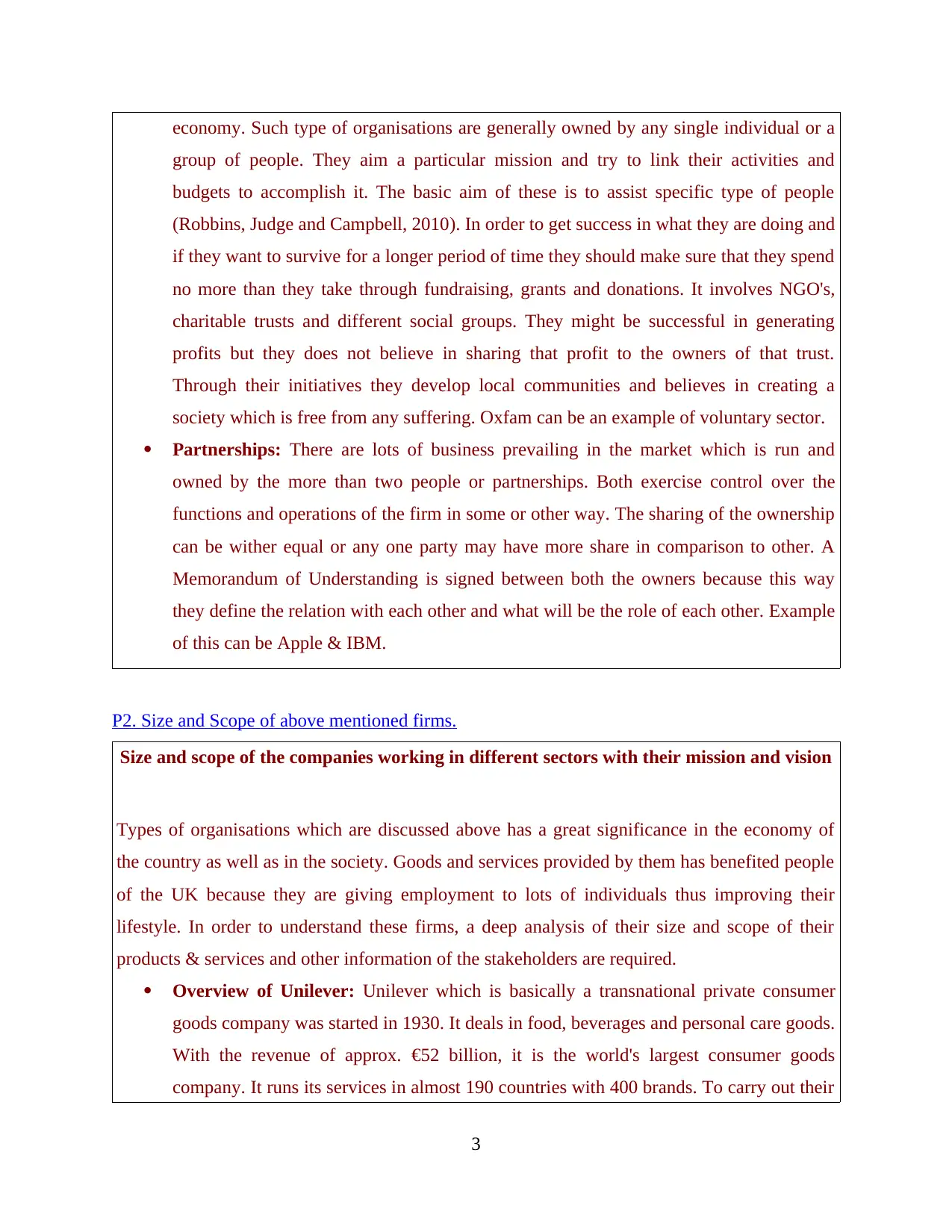
economy. Such type of organisations are generally owned by any single individual or a
group of people. They aim a particular mission and try to link their activities and
budgets to accomplish it. The basic aim of these is to assist specific type of people
(Robbins, Judge and Campbell, 2010). In order to get success in what they are doing and
if they want to survive for a longer period of time they should make sure that they spend
no more than they take through fundraising, grants and donations. It involves NGO's,
charitable trusts and different social groups. They might be successful in generating
profits but they does not believe in sharing that profit to the owners of that trust.
Through their initiatives they develop local communities and believes in creating a
society which is free from any suffering. Oxfam can be an example of voluntary sector.
Partnerships: There are lots of business prevailing in the market which is run and
owned by the more than two people or partnerships. Both exercise control over the
functions and operations of the firm in some or other way. The sharing of the ownership
can be wither equal or any one party may have more share in comparison to other. A
Memorandum of Understanding is signed between both the owners because this way
they define the relation with each other and what will be the role of each other. Example
of this can be Apple & IBM.
P2. Size and Scope of above mentioned firms.
Size and scope of the companies working in different sectors with their mission and vision
Types of organisations which are discussed above has a great significance in the economy of
the country as well as in the society. Goods and services provided by them has benefited people
of the UK because they are giving employment to lots of individuals thus improving their
lifestyle. In order to understand these firms, a deep analysis of their size and scope of their
products & services and other information of the stakeholders are required.
Overview of Unilever: Unilever which is basically a transnational private consumer
goods company was started in 1930. It deals in food, beverages and personal care goods.
With the revenue of approx. €52 billion, it is the world's largest consumer goods
company. It runs its services in almost 190 countries with 400 brands. To carry out their
3
group of people. They aim a particular mission and try to link their activities and
budgets to accomplish it. The basic aim of these is to assist specific type of people
(Robbins, Judge and Campbell, 2010). In order to get success in what they are doing and
if they want to survive for a longer period of time they should make sure that they spend
no more than they take through fundraising, grants and donations. It involves NGO's,
charitable trusts and different social groups. They might be successful in generating
profits but they does not believe in sharing that profit to the owners of that trust.
Through their initiatives they develop local communities and believes in creating a
society which is free from any suffering. Oxfam can be an example of voluntary sector.
Partnerships: There are lots of business prevailing in the market which is run and
owned by the more than two people or partnerships. Both exercise control over the
functions and operations of the firm in some or other way. The sharing of the ownership
can be wither equal or any one party may have more share in comparison to other. A
Memorandum of Understanding is signed between both the owners because this way
they define the relation with each other and what will be the role of each other. Example
of this can be Apple & IBM.
P2. Size and Scope of above mentioned firms.
Size and scope of the companies working in different sectors with their mission and vision
Types of organisations which are discussed above has a great significance in the economy of
the country as well as in the society. Goods and services provided by them has benefited people
of the UK because they are giving employment to lots of individuals thus improving their
lifestyle. In order to understand these firms, a deep analysis of their size and scope of their
products & services and other information of the stakeholders are required.
Overview of Unilever: Unilever which is basically a transnational private consumer
goods company was started in 1930. It deals in food, beverages and personal care goods.
With the revenue of approx. €52 billion, it is the world's largest consumer goods
company. It runs its services in almost 190 countries with 400 brands. To carry out their
3
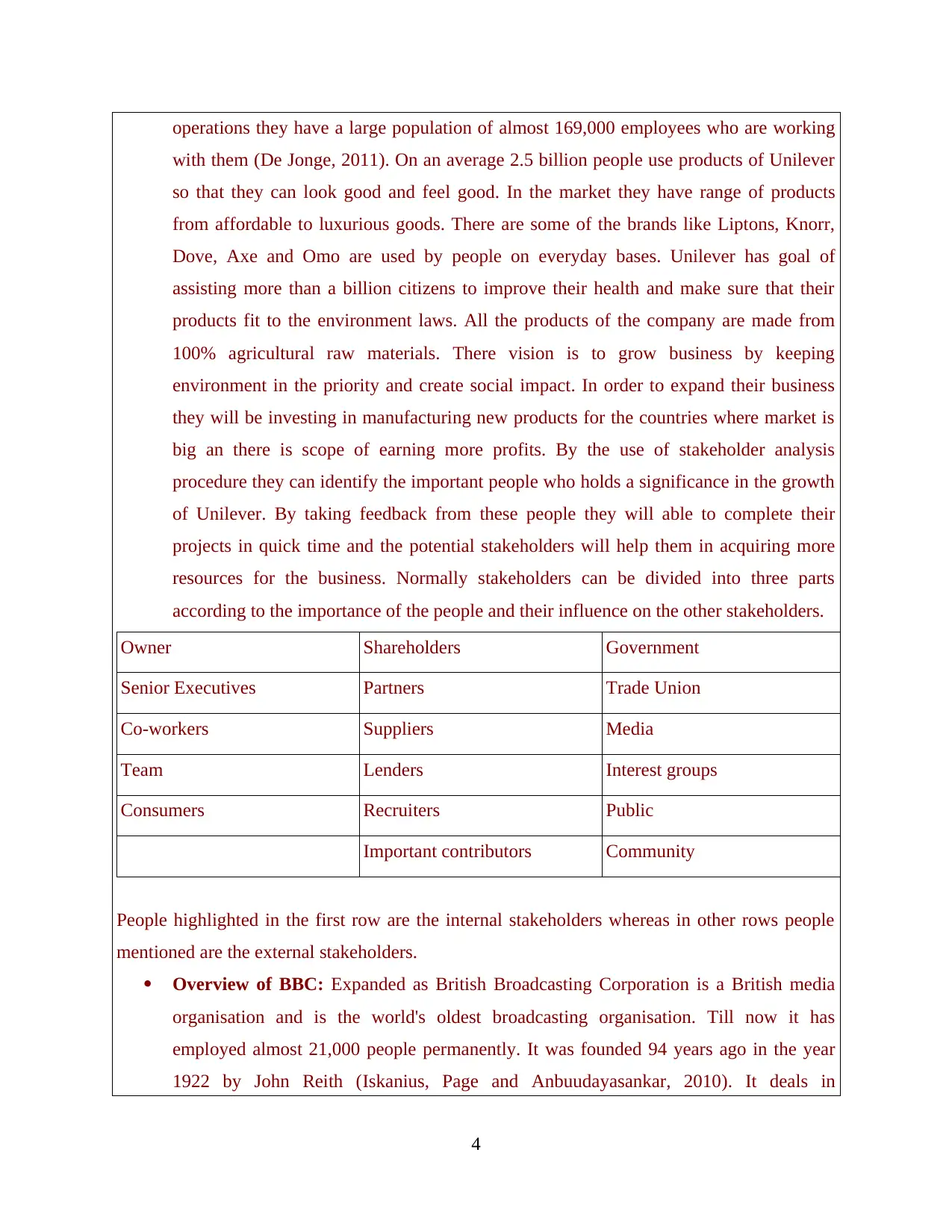
operations they have a large population of almost 169,000 employees who are working
with them (De Jonge, 2011). On an average 2.5 billion people use products of Unilever
so that they can look good and feel good. In the market they have range of products
from affordable to luxurious goods. There are some of the brands like Liptons, Knorr,
Dove, Axe and Omo are used by people on everyday bases. Unilever has goal of
assisting more than a billion citizens to improve their health and make sure that their
products fit to the environment laws. All the products of the company are made from
100% agricultural raw materials. There vision is to grow business by keeping
environment in the priority and create social impact. In order to expand their business
they will be investing in manufacturing new products for the countries where market is
big an there is scope of earning more profits. By the use of stakeholder analysis
procedure they can identify the important people who holds a significance in the growth
of Unilever. By taking feedback from these people they will able to complete their
projects in quick time and the potential stakeholders will help them in acquiring more
resources for the business. Normally stakeholders can be divided into three parts
according to the importance of the people and their influence on the other stakeholders.
Owner Shareholders Government
Senior Executives Partners Trade Union
Co-workers Suppliers Media
Team Lenders Interest groups
Consumers Recruiters Public
Important contributors Community
People highlighted in the first row are the internal stakeholders whereas in other rows people
mentioned are the external stakeholders.
Overview of BBC: Expanded as British Broadcasting Corporation is a British media
organisation and is the world's oldest broadcasting organisation. Till now it has
employed almost 21,000 people permanently. It was founded 94 years ago in the year
1922 by John Reith (Iskanius, Page and Anbuudayasankar, 2010). It deals in
4
with them (De Jonge, 2011). On an average 2.5 billion people use products of Unilever
so that they can look good and feel good. In the market they have range of products
from affordable to luxurious goods. There are some of the brands like Liptons, Knorr,
Dove, Axe and Omo are used by people on everyday bases. Unilever has goal of
assisting more than a billion citizens to improve their health and make sure that their
products fit to the environment laws. All the products of the company are made from
100% agricultural raw materials. There vision is to grow business by keeping
environment in the priority and create social impact. In order to expand their business
they will be investing in manufacturing new products for the countries where market is
big an there is scope of earning more profits. By the use of stakeholder analysis
procedure they can identify the important people who holds a significance in the growth
of Unilever. By taking feedback from these people they will able to complete their
projects in quick time and the potential stakeholders will help them in acquiring more
resources for the business. Normally stakeholders can be divided into three parts
according to the importance of the people and their influence on the other stakeholders.
Owner Shareholders Government
Senior Executives Partners Trade Union
Co-workers Suppliers Media
Team Lenders Interest groups
Consumers Recruiters Public
Important contributors Community
People highlighted in the first row are the internal stakeholders whereas in other rows people
mentioned are the external stakeholders.
Overview of BBC: Expanded as British Broadcasting Corporation is a British media
organisation and is the world's oldest broadcasting organisation. Till now it has
employed almost 21,000 people permanently. It was founded 94 years ago in the year
1922 by John Reith (Iskanius, Page and Anbuudayasankar, 2010). It deals in
4
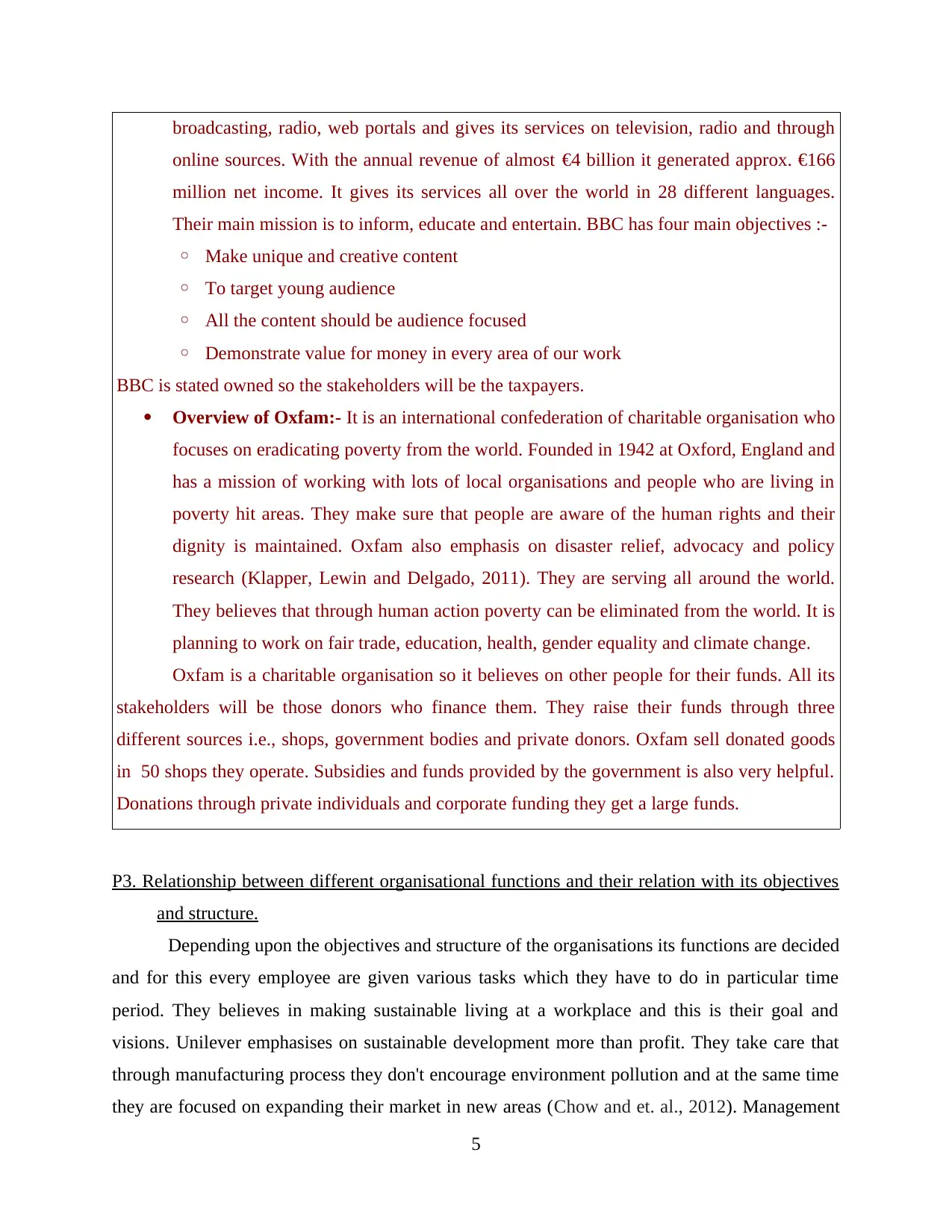
broadcasting, radio, web portals and gives its services on television, radio and through
online sources. With the annual revenue of almost €4 billion it generated approx. €166
million net income. It gives its services all over the world in 28 different languages.
Their main mission is to inform, educate and entertain. BBC has four main objectives :-
◦ Make unique and creative content
◦ To target young audience
◦ All the content should be audience focused
◦ Demonstrate value for money in every area of our work
BBC is stated owned so the stakeholders will be the taxpayers.
Overview of Oxfam:- It is an international confederation of charitable organisation who
focuses on eradicating poverty from the world. Founded in 1942 at Oxford, England and
has a mission of working with lots of local organisations and people who are living in
poverty hit areas. They make sure that people are aware of the human rights and their
dignity is maintained. Oxfam also emphasis on disaster relief, advocacy and policy
research (Klapper, Lewin and Delgado, 2011). They are serving all around the world.
They believes that through human action poverty can be eliminated from the world. It is
planning to work on fair trade, education, health, gender equality and climate change.
Oxfam is a charitable organisation so it believes on other people for their funds. All its
stakeholders will be those donors who finance them. They raise their funds through three
different sources i.e., shops, government bodies and private donors. Oxfam sell donated goods
in 50 shops they operate. Subsidies and funds provided by the government is also very helpful.
Donations through private individuals and corporate funding they get a large funds.
P3. Relationship between different organisational functions and their relation with its objectives
and structure.
Depending upon the objectives and structure of the organisations its functions are decided
and for this every employee are given various tasks which they have to do in particular time
period. They believes in making sustainable living at a workplace and this is their goal and
visions. Unilever emphasises on sustainable development more than profit. They take care that
through manufacturing process they don't encourage environment pollution and at the same time
they are focused on expanding their market in new areas (Chow and et. al., 2012). Management
5
online sources. With the annual revenue of almost €4 billion it generated approx. €166
million net income. It gives its services all over the world in 28 different languages.
Their main mission is to inform, educate and entertain. BBC has four main objectives :-
◦ Make unique and creative content
◦ To target young audience
◦ All the content should be audience focused
◦ Demonstrate value for money in every area of our work
BBC is stated owned so the stakeholders will be the taxpayers.
Overview of Oxfam:- It is an international confederation of charitable organisation who
focuses on eradicating poverty from the world. Founded in 1942 at Oxford, England and
has a mission of working with lots of local organisations and people who are living in
poverty hit areas. They make sure that people are aware of the human rights and their
dignity is maintained. Oxfam also emphasis on disaster relief, advocacy and policy
research (Klapper, Lewin and Delgado, 2011). They are serving all around the world.
They believes that through human action poverty can be eliminated from the world. It is
planning to work on fair trade, education, health, gender equality and climate change.
Oxfam is a charitable organisation so it believes on other people for their funds. All its
stakeholders will be those donors who finance them. They raise their funds through three
different sources i.e., shops, government bodies and private donors. Oxfam sell donated goods
in 50 shops they operate. Subsidies and funds provided by the government is also very helpful.
Donations through private individuals and corporate funding they get a large funds.
P3. Relationship between different organisational functions and their relation with its objectives
and structure.
Depending upon the objectives and structure of the organisations its functions are decided
and for this every employee are given various tasks which they have to do in particular time
period. They believes in making sustainable living at a workplace and this is their goal and
visions. Unilever emphasises on sustainable development more than profit. They take care that
through manufacturing process they don't encourage environment pollution and at the same time
they are focused on expanding their market in new areas (Chow and et. al., 2012). Management
5
Paraphrase This Document
Need a fresh take? Get an instant paraphrase of this document with our AI Paraphraser
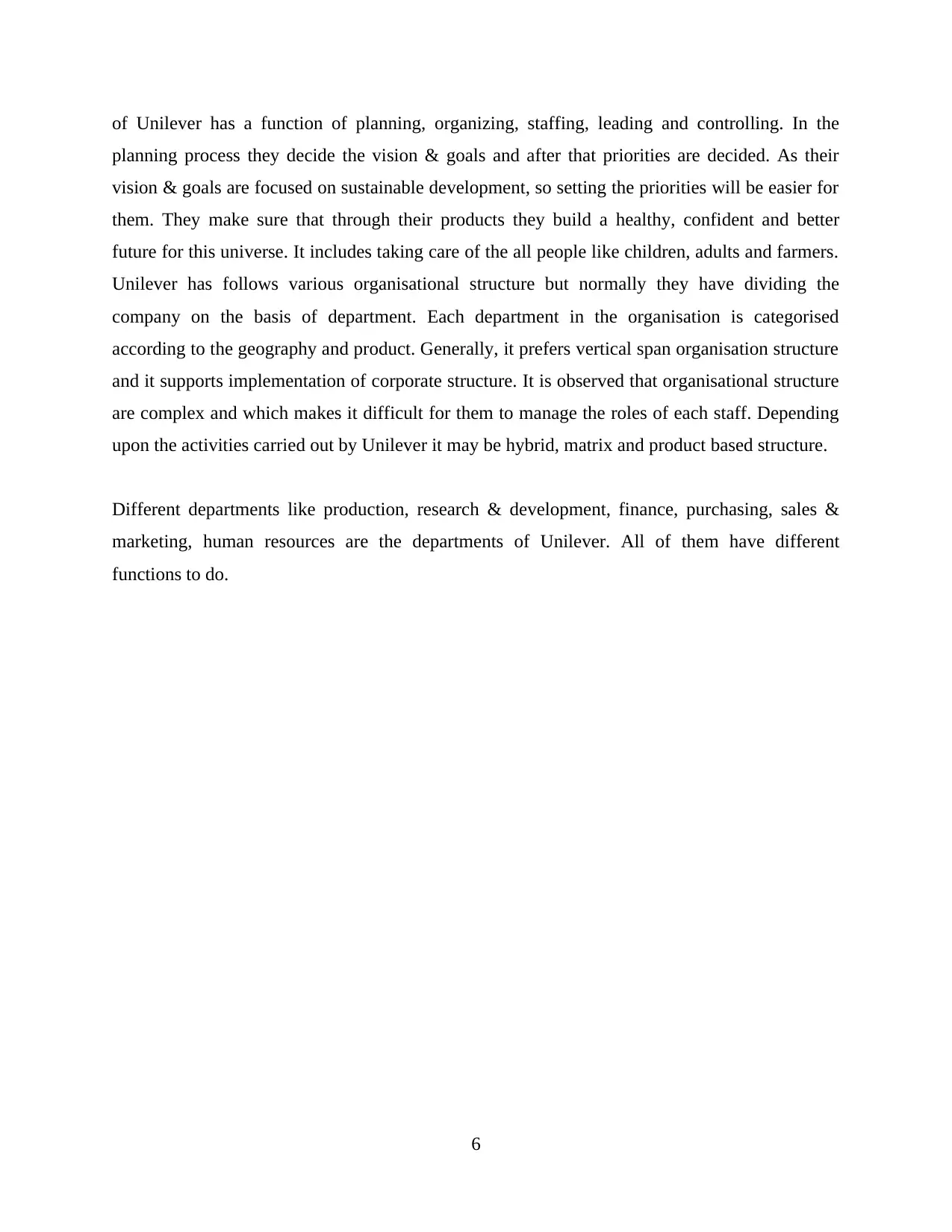
of Unilever has a function of planning, organizing, staffing, leading and controlling. In the
planning process they decide the vision & goals and after that priorities are decided. As their
vision & goals are focused on sustainable development, so setting the priorities will be easier for
them. They make sure that through their products they build a healthy, confident and better
future for this universe. It includes taking care of the all people like children, adults and farmers.
Unilever has follows various organisational structure but normally they have dividing the
company on the basis of department. Each department in the organisation is categorised
according to the geography and product. Generally, it prefers vertical span organisation structure
and it supports implementation of corporate structure. It is observed that organisational structure
are complex and which makes it difficult for them to manage the roles of each staff. Depending
upon the activities carried out by Unilever it may be hybrid, matrix and product based structure.
Different departments like production, research & development, finance, purchasing, sales &
marketing, human resources are the departments of Unilever. All of them have different
functions to do.
6
planning process they decide the vision & goals and after that priorities are decided. As their
vision & goals are focused on sustainable development, so setting the priorities will be easier for
them. They make sure that through their products they build a healthy, confident and better
future for this universe. It includes taking care of the all people like children, adults and farmers.
Unilever has follows various organisational structure but normally they have dividing the
company on the basis of department. Each department in the organisation is categorised
according to the geography and product. Generally, it prefers vertical span organisation structure
and it supports implementation of corporate structure. It is observed that organisational structure
are complex and which makes it difficult for them to manage the roles of each staff. Depending
upon the activities carried out by Unilever it may be hybrid, matrix and product based structure.
Different departments like production, research & development, finance, purchasing, sales &
marketing, human resources are the departments of Unilever. All of them have different
functions to do.
6
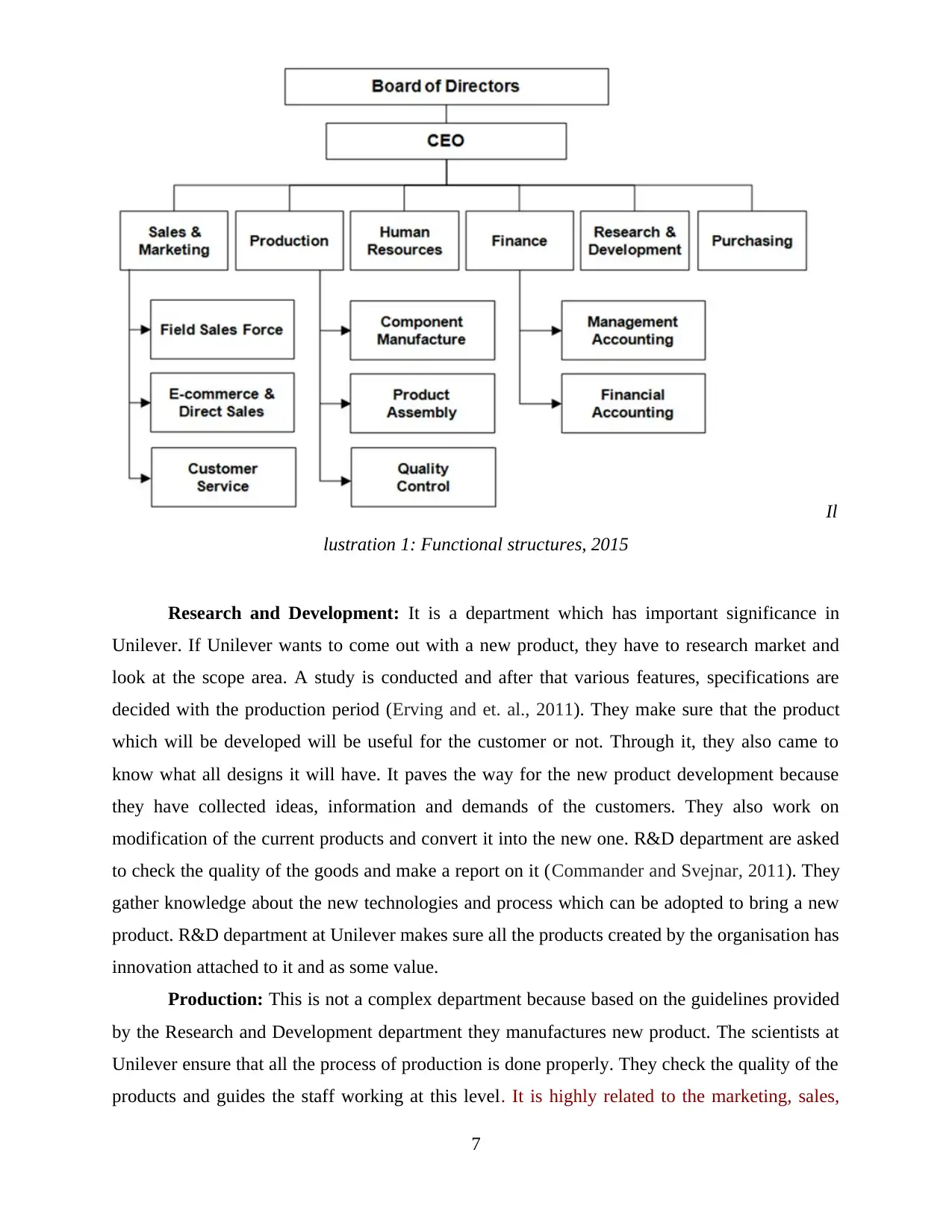
Research and Development: It is a department which has important significance in
Unilever. If Unilever wants to come out with a new product, they have to research market and
look at the scope area. A study is conducted and after that various features, specifications are
decided with the production period (Erving and et. al., 2011). They make sure that the product
which will be developed will be useful for the customer or not. Through it, they also came to
know what all designs it will have. It paves the way for the new product development because
they have collected ideas, information and demands of the customers. They also work on
modification of the current products and convert it into the new one. R&D department are asked
to check the quality of the goods and make a report on it (Commander and Svejnar, 2011). They
gather knowledge about the new technologies and process which can be adopted to bring a new
product. R&D department at Unilever makes sure all the products created by the organisation has
innovation attached to it and as some value.
Production: This is not a complex department because based on the guidelines provided
by the Research and Development department they manufactures new product. The scientists at
Unilever ensure that all the process of production is done properly. They check the quality of the
products and guides the staff working at this level. It is highly related to the marketing, sales,
7
Il
lustration 1: Functional structures, 2015
Unilever. If Unilever wants to come out with a new product, they have to research market and
look at the scope area. A study is conducted and after that various features, specifications are
decided with the production period (Erving and et. al., 2011). They make sure that the product
which will be developed will be useful for the customer or not. Through it, they also came to
know what all designs it will have. It paves the way for the new product development because
they have collected ideas, information and demands of the customers. They also work on
modification of the current products and convert it into the new one. R&D department are asked
to check the quality of the goods and make a report on it (Commander and Svejnar, 2011). They
gather knowledge about the new technologies and process which can be adopted to bring a new
product. R&D department at Unilever makes sure all the products created by the organisation has
innovation attached to it and as some value.
Production: This is not a complex department because based on the guidelines provided
by the Research and Development department they manufactures new product. The scientists at
Unilever ensure that all the process of production is done properly. They check the quality of the
products and guides the staff working at this level. It is highly related to the marketing, sales,
7
Il
lustration 1: Functional structures, 2015
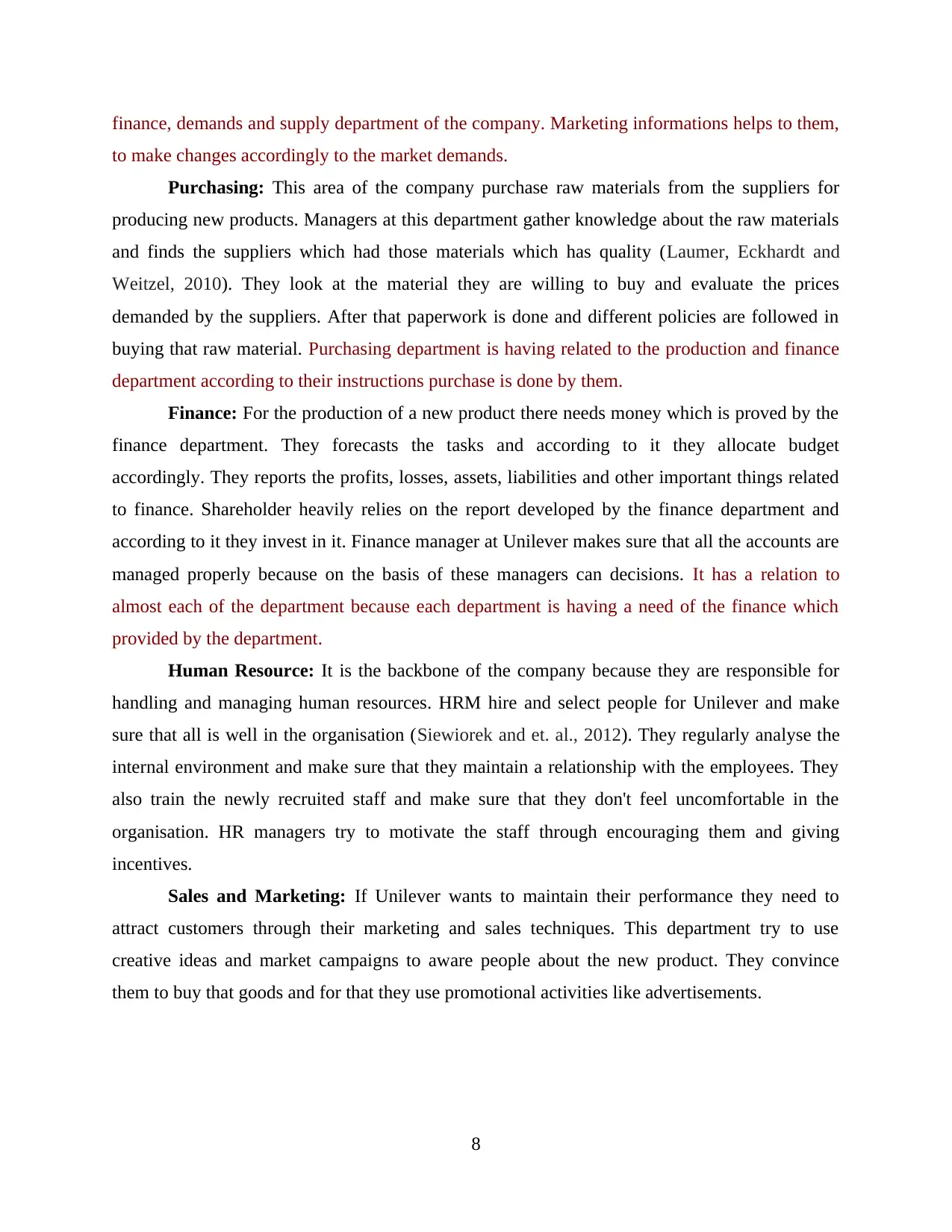
finance, demands and supply department of the company. Marketing informations helps to them,
to make changes accordingly to the market demands.
Purchasing: This area of the company purchase raw materials from the suppliers for
producing new products. Managers at this department gather knowledge about the raw materials
and finds the suppliers which had those materials which has quality (Laumer, Eckhardt and
Weitzel, 2010). They look at the material they are willing to buy and evaluate the prices
demanded by the suppliers. After that paperwork is done and different policies are followed in
buying that raw material. Purchasing department is having related to the production and finance
department according to their instructions purchase is done by them.
Finance: For the production of a new product there needs money which is proved by the
finance department. They forecasts the tasks and according to it they allocate budget
accordingly. They reports the profits, losses, assets, liabilities and other important things related
to finance. Shareholder heavily relies on the report developed by the finance department and
according to it they invest in it. Finance manager at Unilever makes sure that all the accounts are
managed properly because on the basis of these managers can decisions. It has a relation to
almost each of the department because each department is having a need of the finance which
provided by the department.
Human Resource: It is the backbone of the company because they are responsible for
handling and managing human resources. HRM hire and select people for Unilever and make
sure that all is well in the organisation (Siewiorek and et. al., 2012). They regularly analyse the
internal environment and make sure that they maintain a relationship with the employees. They
also train the newly recruited staff and make sure that they don't feel uncomfortable in the
organisation. HR managers try to motivate the staff through encouraging them and giving
incentives.
Sales and Marketing: If Unilever wants to maintain their performance they need to
attract customers through their marketing and sales techniques. This department try to use
creative ideas and market campaigns to aware people about the new product. They convince
them to buy that goods and for that they use promotional activities like advertisements.
8
to make changes accordingly to the market demands.
Purchasing: This area of the company purchase raw materials from the suppliers for
producing new products. Managers at this department gather knowledge about the raw materials
and finds the suppliers which had those materials which has quality (Laumer, Eckhardt and
Weitzel, 2010). They look at the material they are willing to buy and evaluate the prices
demanded by the suppliers. After that paperwork is done and different policies are followed in
buying that raw material. Purchasing department is having related to the production and finance
department according to their instructions purchase is done by them.
Finance: For the production of a new product there needs money which is proved by the
finance department. They forecasts the tasks and according to it they allocate budget
accordingly. They reports the profits, losses, assets, liabilities and other important things related
to finance. Shareholder heavily relies on the report developed by the finance department and
according to it they invest in it. Finance manager at Unilever makes sure that all the accounts are
managed properly because on the basis of these managers can decisions. It has a relation to
almost each of the department because each department is having a need of the finance which
provided by the department.
Human Resource: It is the backbone of the company because they are responsible for
handling and managing human resources. HRM hire and select people for Unilever and make
sure that all is well in the organisation (Siewiorek and et. al., 2012). They regularly analyse the
internal environment and make sure that they maintain a relationship with the employees. They
also train the newly recruited staff and make sure that they don't feel uncomfortable in the
organisation. HR managers try to motivate the staff through encouraging them and giving
incentives.
Sales and Marketing: If Unilever wants to maintain their performance they need to
attract customers through their marketing and sales techniques. This department try to use
creative ideas and market campaigns to aware people about the new product. They convince
them to buy that goods and for that they use promotional activities like advertisements.
8
Secure Best Marks with AI Grader
Need help grading? Try our AI Grader for instant feedback on your assignments.
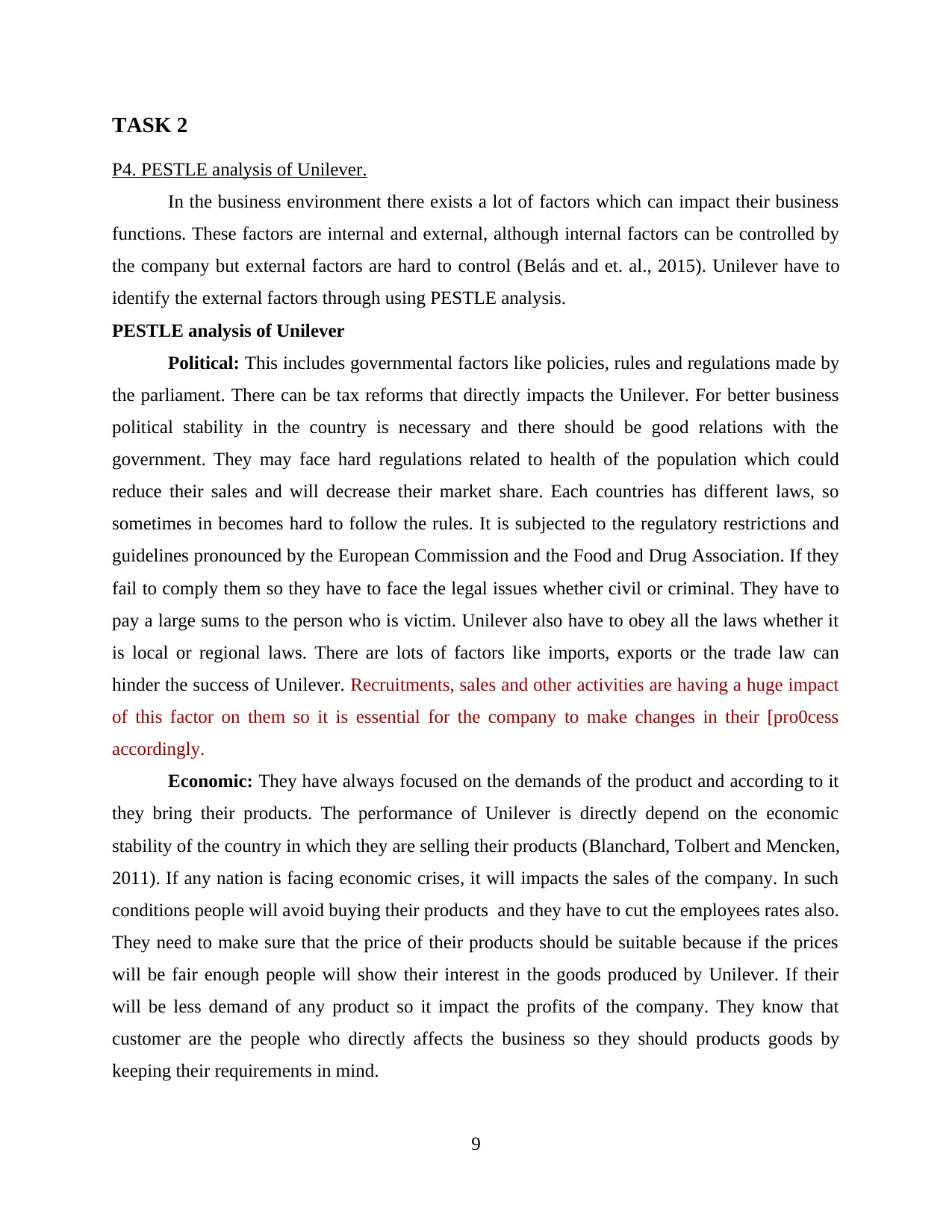
TASK 2
P4. PESTLE analysis of Unilever.
In the business environment there exists a lot of factors which can impact their business
functions. These factors are internal and external, although internal factors can be controlled by
the company but external factors are hard to control (Belás and et. al., 2015). Unilever have to
identify the external factors through using PESTLE analysis.
PESTLE analysis of Unilever
Political: This includes governmental factors like policies, rules and regulations made by
the parliament. There can be tax reforms that directly impacts the Unilever. For better business
political stability in the country is necessary and there should be good relations with the
government. They may face hard regulations related to health of the population which could
reduce their sales and will decrease their market share. Each countries has different laws, so
sometimes in becomes hard to follow the rules. It is subjected to the regulatory restrictions and
guidelines pronounced by the European Commission and the Food and Drug Association. If they
fail to comply them so they have to face the legal issues whether civil or criminal. They have to
pay a large sums to the person who is victim. Unilever also have to obey all the laws whether it
is local or regional laws. There are lots of factors like imports, exports or the trade law can
hinder the success of Unilever. Recruitments, sales and other activities are having a huge impact
of this factor on them so it is essential for the company to make changes in their [pro0cess
accordingly.
Economic: They have always focused on the demands of the product and according to it
they bring their products. The performance of Unilever is directly depend on the economic
stability of the country in which they are selling their products (Blanchard, Tolbert and Mencken,
2011). If any nation is facing economic crises, it will impacts the sales of the company. In such
conditions people will avoid buying their products and they have to cut the employees rates also.
They need to make sure that the price of their products should be suitable because if the prices
will be fair enough people will show their interest in the goods produced by Unilever. If their
will be less demand of any product so it impact the profits of the company. They know that
customer are the people who directly affects the business so they should products goods by
keeping their requirements in mind.
9
P4. PESTLE analysis of Unilever.
In the business environment there exists a lot of factors which can impact their business
functions. These factors are internal and external, although internal factors can be controlled by
the company but external factors are hard to control (Belás and et. al., 2015). Unilever have to
identify the external factors through using PESTLE analysis.
PESTLE analysis of Unilever
Political: This includes governmental factors like policies, rules and regulations made by
the parliament. There can be tax reforms that directly impacts the Unilever. For better business
political stability in the country is necessary and there should be good relations with the
government. They may face hard regulations related to health of the population which could
reduce their sales and will decrease their market share. Each countries has different laws, so
sometimes in becomes hard to follow the rules. It is subjected to the regulatory restrictions and
guidelines pronounced by the European Commission and the Food and Drug Association. If they
fail to comply them so they have to face the legal issues whether civil or criminal. They have to
pay a large sums to the person who is victim. Unilever also have to obey all the laws whether it
is local or regional laws. There are lots of factors like imports, exports or the trade law can
hinder the success of Unilever. Recruitments, sales and other activities are having a huge impact
of this factor on them so it is essential for the company to make changes in their [pro0cess
accordingly.
Economic: They have always focused on the demands of the product and according to it
they bring their products. The performance of Unilever is directly depend on the economic
stability of the country in which they are selling their products (Blanchard, Tolbert and Mencken,
2011). If any nation is facing economic crises, it will impacts the sales of the company. In such
conditions people will avoid buying their products and they have to cut the employees rates also.
They need to make sure that the price of their products should be suitable because if the prices
will be fair enough people will show their interest in the goods produced by Unilever. If their
will be less demand of any product so it impact the profits of the company. They know that
customer are the people who directly affects the business so they should products goods by
keeping their requirements in mind.
9
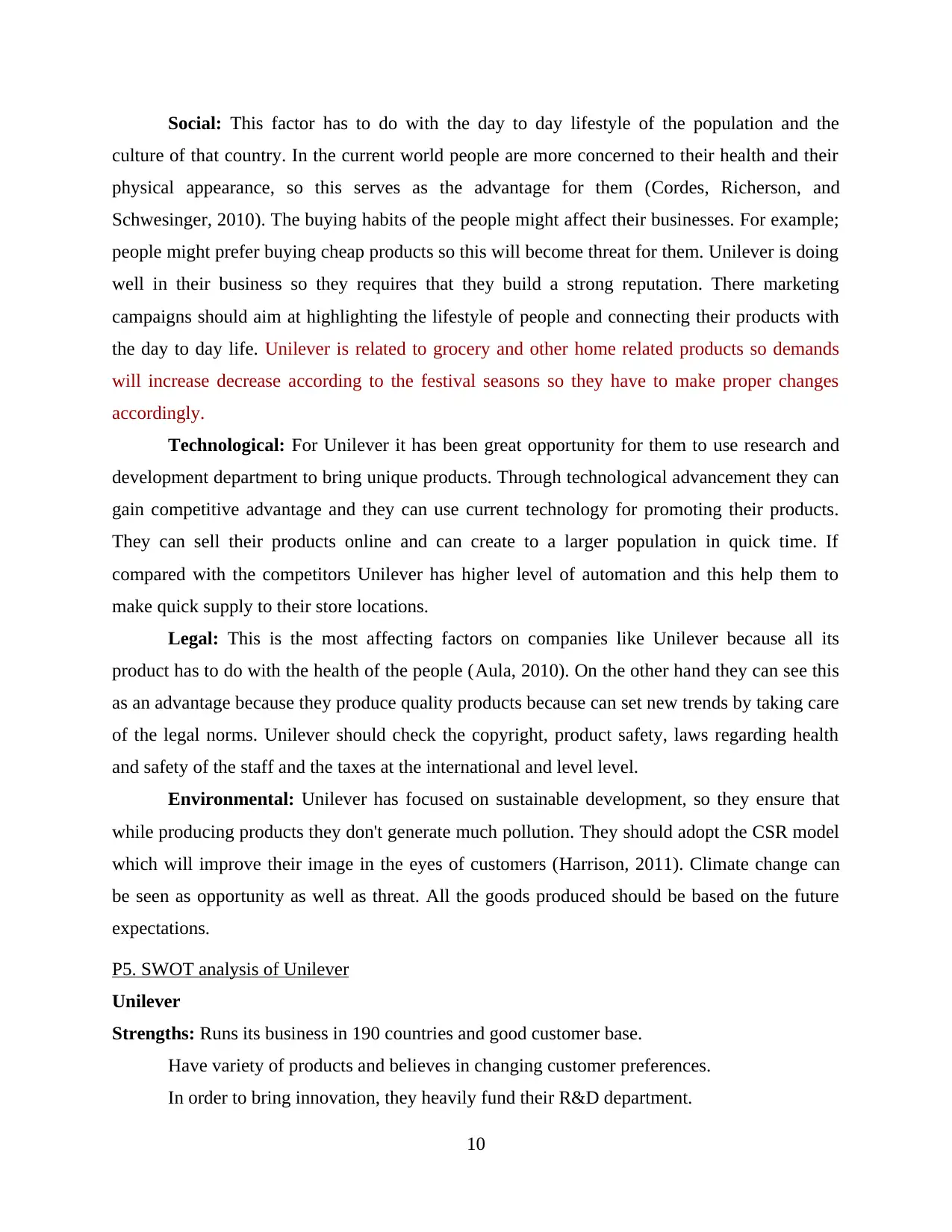
Social: This factor has to do with the day to day lifestyle of the population and the
culture of that country. In the current world people are more concerned to their health and their
physical appearance, so this serves as the advantage for them (Cordes, Richerson, and
Schwesinger, 2010). The buying habits of the people might affect their businesses. For example;
people might prefer buying cheap products so this will become threat for them. Unilever is doing
well in their business so they requires that they build a strong reputation. There marketing
campaigns should aim at highlighting the lifestyle of people and connecting their products with
the day to day life. Unilever is related to grocery and other home related products so demands
will increase decrease according to the festival seasons so they have to make proper changes
accordingly.
Technological: For Unilever it has been great opportunity for them to use research and
development department to bring unique products. Through technological advancement they can
gain competitive advantage and they can use current technology for promoting their products.
They can sell their products online and can create to a larger population in quick time. If
compared with the competitors Unilever has higher level of automation and this help them to
make quick supply to their store locations.
Legal: This is the most affecting factors on companies like Unilever because all its
product has to do with the health of the people (Aula, 2010). On the other hand they can see this
as an advantage because they produce quality products because can set new trends by taking care
of the legal norms. Unilever should check the copyright, product safety, laws regarding health
and safety of the staff and the taxes at the international and level level.
Environmental: Unilever has focused on sustainable development, so they ensure that
while producing products they don't generate much pollution. They should adopt the CSR model
which will improve their image in the eyes of customers (Harrison, 2011). Climate change can
be seen as opportunity as well as threat. All the goods produced should be based on the future
expectations.
P5. SWOT analysis of Unilever
Unilever
Strengths: Runs its business in 190 countries and good customer base.
Have variety of products and believes in changing customer preferences.
In order to bring innovation, they heavily fund their R&D department.
10
culture of that country. In the current world people are more concerned to their health and their
physical appearance, so this serves as the advantage for them (Cordes, Richerson, and
Schwesinger, 2010). The buying habits of the people might affect their businesses. For example;
people might prefer buying cheap products so this will become threat for them. Unilever is doing
well in their business so they requires that they build a strong reputation. There marketing
campaigns should aim at highlighting the lifestyle of people and connecting their products with
the day to day life. Unilever is related to grocery and other home related products so demands
will increase decrease according to the festival seasons so they have to make proper changes
accordingly.
Technological: For Unilever it has been great opportunity for them to use research and
development department to bring unique products. Through technological advancement they can
gain competitive advantage and they can use current technology for promoting their products.
They can sell their products online and can create to a larger population in quick time. If
compared with the competitors Unilever has higher level of automation and this help them to
make quick supply to their store locations.
Legal: This is the most affecting factors on companies like Unilever because all its
product has to do with the health of the people (Aula, 2010). On the other hand they can see this
as an advantage because they produce quality products because can set new trends by taking care
of the legal norms. Unilever should check the copyright, product safety, laws regarding health
and safety of the staff and the taxes at the international and level level.
Environmental: Unilever has focused on sustainable development, so they ensure that
while producing products they don't generate much pollution. They should adopt the CSR model
which will improve their image in the eyes of customers (Harrison, 2011). Climate change can
be seen as opportunity as well as threat. All the goods produced should be based on the future
expectations.
P5. SWOT analysis of Unilever
Unilever
Strengths: Runs its business in 190 countries and good customer base.
Have variety of products and believes in changing customer preferences.
In order to bring innovation, they heavily fund their R&D department.
10
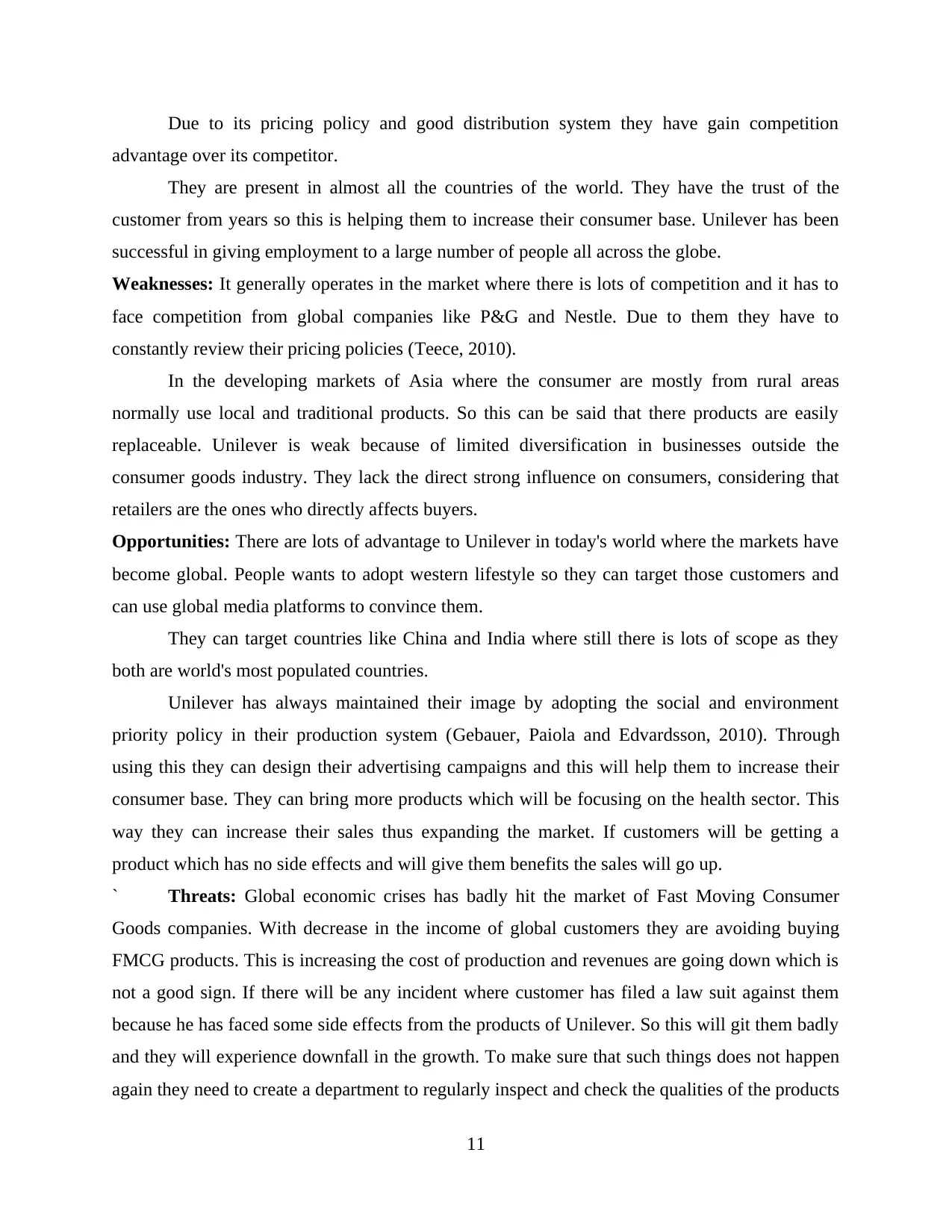
Due to its pricing policy and good distribution system they have gain competition
advantage over its competitor.
They are present in almost all the countries of the world. They have the trust of the
customer from years so this is helping them to increase their consumer base. Unilever has been
successful in giving employment to a large number of people all across the globe.
Weaknesses: It generally operates in the market where there is lots of competition and it has to
face competition from global companies like P&G and Nestle. Due to them they have to
constantly review their pricing policies (Teece, 2010).
In the developing markets of Asia where the consumer are mostly from rural areas
normally use local and traditional products. So this can be said that there products are easily
replaceable. Unilever is weak because of limited diversification in businesses outside the
consumer goods industry. They lack the direct strong influence on consumers, considering that
retailers are the ones who directly affects buyers.
Opportunities: There are lots of advantage to Unilever in today's world where the markets have
become global. People wants to adopt western lifestyle so they can target those customers and
can use global media platforms to convince them.
They can target countries like China and India where still there is lots of scope as they
both are world's most populated countries.
Unilever has always maintained their image by adopting the social and environment
priority policy in their production system (Gebauer, Paiola and Edvardsson, 2010). Through
using this they can design their advertising campaigns and this will help them to increase their
consumer base. They can bring more products which will be focusing on the health sector. This
way they can increase their sales thus expanding the market. If customers will be getting a
product which has no side effects and will give them benefits the sales will go up.
` Threats: Global economic crises has badly hit the market of Fast Moving Consumer
Goods companies. With decrease in the income of global customers they are avoiding buying
FMCG products. This is increasing the cost of production and revenues are going down which is
not a good sign. If there will be any incident where customer has filed a law suit against them
because he has faced some side effects from the products of Unilever. So this will git them badly
and they will experience downfall in the growth. To make sure that such things does not happen
again they need to create a department to regularly inspect and check the qualities of the products
11
advantage over its competitor.
They are present in almost all the countries of the world. They have the trust of the
customer from years so this is helping them to increase their consumer base. Unilever has been
successful in giving employment to a large number of people all across the globe.
Weaknesses: It generally operates in the market where there is lots of competition and it has to
face competition from global companies like P&G and Nestle. Due to them they have to
constantly review their pricing policies (Teece, 2010).
In the developing markets of Asia where the consumer are mostly from rural areas
normally use local and traditional products. So this can be said that there products are easily
replaceable. Unilever is weak because of limited diversification in businesses outside the
consumer goods industry. They lack the direct strong influence on consumers, considering that
retailers are the ones who directly affects buyers.
Opportunities: There are lots of advantage to Unilever in today's world where the markets have
become global. People wants to adopt western lifestyle so they can target those customers and
can use global media platforms to convince them.
They can target countries like China and India where still there is lots of scope as they
both are world's most populated countries.
Unilever has always maintained their image by adopting the social and environment
priority policy in their production system (Gebauer, Paiola and Edvardsson, 2010). Through
using this they can design their advertising campaigns and this will help them to increase their
consumer base. They can bring more products which will be focusing on the health sector. This
way they can increase their sales thus expanding the market. If customers will be getting a
product which has no side effects and will give them benefits the sales will go up.
` Threats: Global economic crises has badly hit the market of Fast Moving Consumer
Goods companies. With decrease in the income of global customers they are avoiding buying
FMCG products. This is increasing the cost of production and revenues are going down which is
not a good sign. If there will be any incident where customer has filed a law suit against them
because he has faced some side effects from the products of Unilever. So this will git them badly
and they will experience downfall in the growth. To make sure that such things does not happen
again they need to create a department to regularly inspect and check the qualities of the products
11
Paraphrase This Document
Need a fresh take? Get an instant paraphrase of this document with our AI Paraphraser
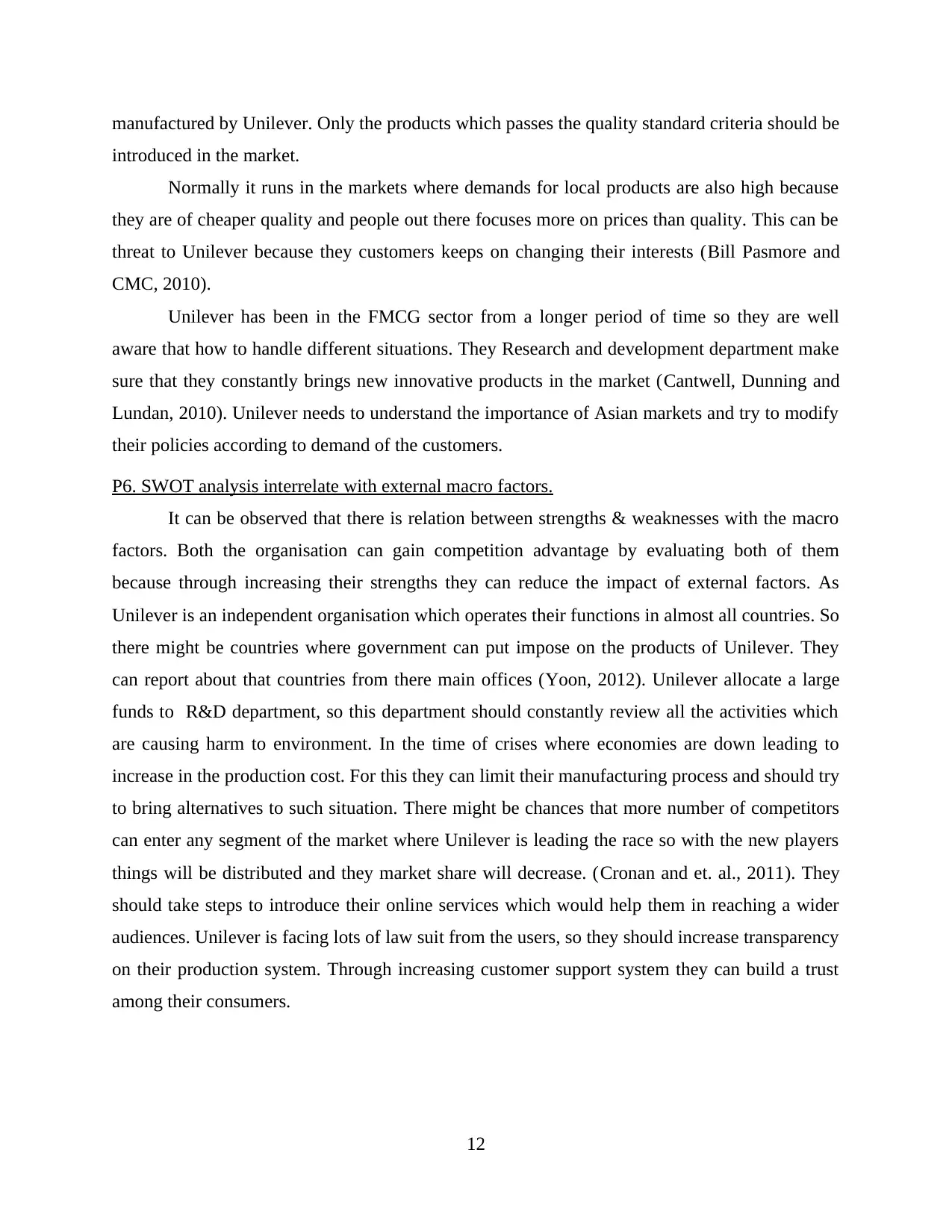
manufactured by Unilever. Only the products which passes the quality standard criteria should be
introduced in the market.
Normally it runs in the markets where demands for local products are also high because
they are of cheaper quality and people out there focuses more on prices than quality. This can be
threat to Unilever because they customers keeps on changing their interests (Bill Pasmore and
CMC, 2010).
Unilever has been in the FMCG sector from a longer period of time so they are well
aware that how to handle different situations. They Research and development department make
sure that they constantly brings new innovative products in the market (Cantwell, Dunning and
Lundan, 2010). Unilever needs to understand the importance of Asian markets and try to modify
their policies according to demand of the customers.
P6. SWOT analysis interrelate with external macro factors.
It can be observed that there is relation between strengths & weaknesses with the macro
factors. Both the organisation can gain competition advantage by evaluating both of them
because through increasing their strengths they can reduce the impact of external factors. As
Unilever is an independent organisation which operates their functions in almost all countries. So
there might be countries where government can put impose on the products of Unilever. They
can report about that countries from there main offices (Yoon, 2012). Unilever allocate a large
funds to R&D department, so this department should constantly review all the activities which
are causing harm to environment. In the time of crises where economies are down leading to
increase in the production cost. For this they can limit their manufacturing process and should try
to bring alternatives to such situation. There might be chances that more number of competitors
can enter any segment of the market where Unilever is leading the race so with the new players
things will be distributed and they market share will decrease. (Cronan and et. al., 2011). They
should take steps to introduce their online services which would help them in reaching a wider
audiences. Unilever is facing lots of law suit from the users, so they should increase transparency
on their production system. Through increasing customer support system they can build a trust
among their consumers.
12
introduced in the market.
Normally it runs in the markets where demands for local products are also high because
they are of cheaper quality and people out there focuses more on prices than quality. This can be
threat to Unilever because they customers keeps on changing their interests (Bill Pasmore and
CMC, 2010).
Unilever has been in the FMCG sector from a longer period of time so they are well
aware that how to handle different situations. They Research and development department make
sure that they constantly brings new innovative products in the market (Cantwell, Dunning and
Lundan, 2010). Unilever needs to understand the importance of Asian markets and try to modify
their policies according to demand of the customers.
P6. SWOT analysis interrelate with external macro factors.
It can be observed that there is relation between strengths & weaknesses with the macro
factors. Both the organisation can gain competition advantage by evaluating both of them
because through increasing their strengths they can reduce the impact of external factors. As
Unilever is an independent organisation which operates their functions in almost all countries. So
there might be countries where government can put impose on the products of Unilever. They
can report about that countries from there main offices (Yoon, 2012). Unilever allocate a large
funds to R&D department, so this department should constantly review all the activities which
are causing harm to environment. In the time of crises where economies are down leading to
increase in the production cost. For this they can limit their manufacturing process and should try
to bring alternatives to such situation. There might be chances that more number of competitors
can enter any segment of the market where Unilever is leading the race so with the new players
things will be distributed and they market share will decrease. (Cronan and et. al., 2011). They
should take steps to introduce their online services which would help them in reaching a wider
audiences. Unilever is facing lots of law suit from the users, so they should increase transparency
on their production system. Through increasing customer support system they can build a trust
among their consumers.
12
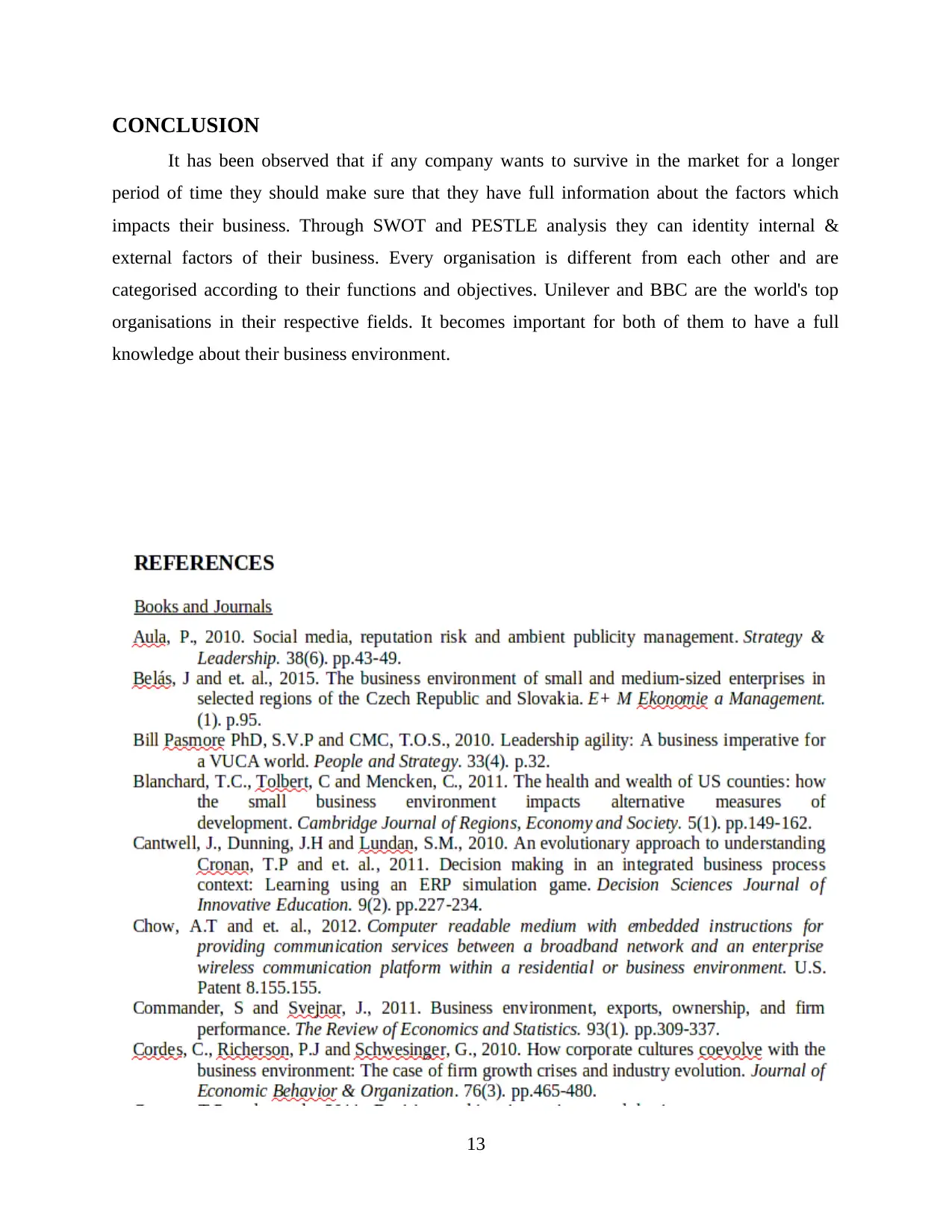
CONCLUSION
It has been observed that if any company wants to survive in the market for a longer
period of time they should make sure that they have full information about the factors which
impacts their business. Through SWOT and PESTLE analysis they can identity internal &
external factors of their business. Every organisation is different from each other and are
categorised according to their functions and objectives. Unilever and BBC are the world's top
organisations in their respective fields. It becomes important for both of them to have a full
knowledge about their business environment.
13
It has been observed that if any company wants to survive in the market for a longer
period of time they should make sure that they have full information about the factors which
impacts their business. Through SWOT and PESTLE analysis they can identity internal &
external factors of their business. Every organisation is different from each other and are
categorised according to their functions and objectives. Unilever and BBC are the world's top
organisations in their respective fields. It becomes important for both of them to have a full
knowledge about their business environment.
13
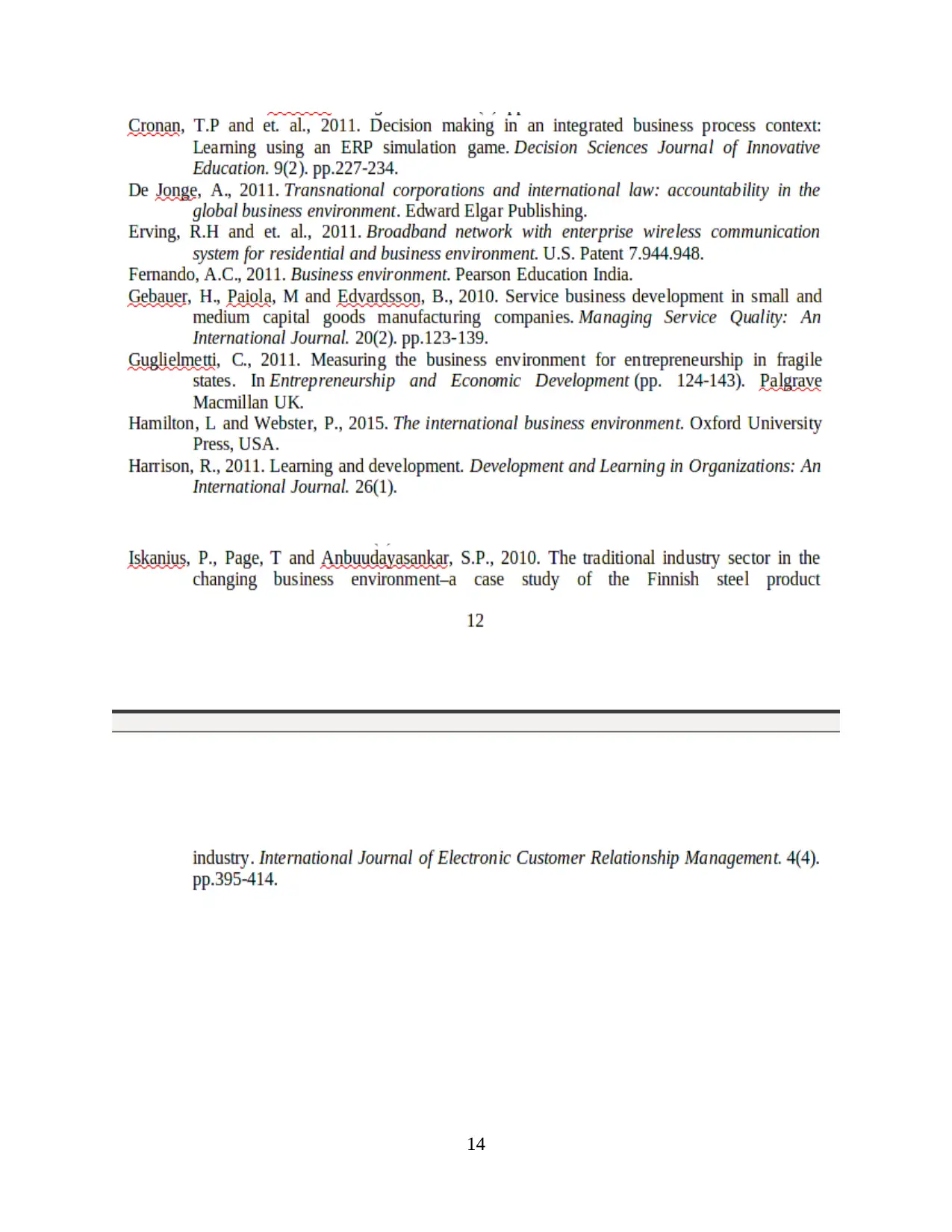
14
Secure Best Marks with AI Grader
Need help grading? Try our AI Grader for instant feedback on your assignments.
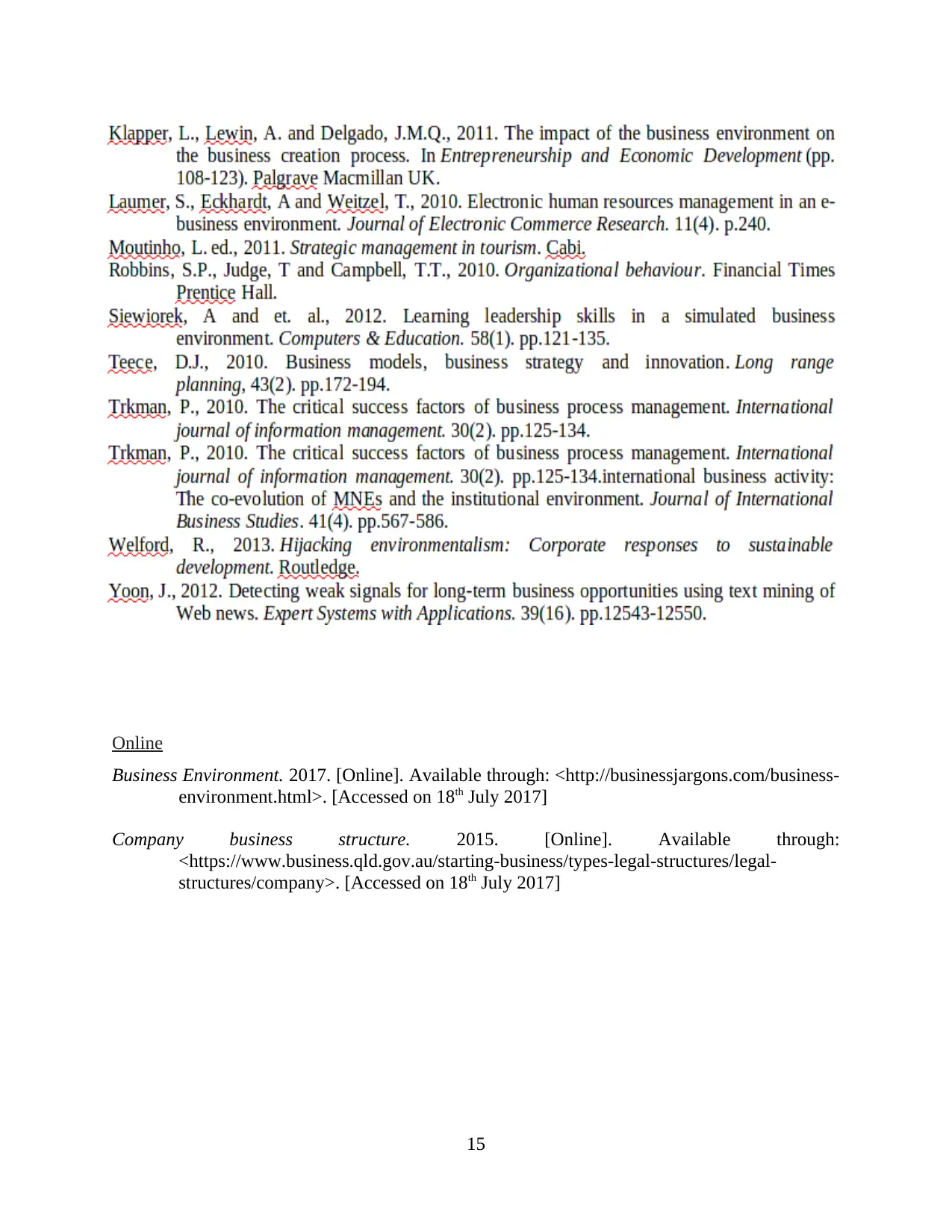
Online
Business Environment. 2017. [Online]. Available through: <http://businessjargons.com/business-
environment.html>. [Accessed on 18th July 2017]
Company business structure. 2015. [Online]. Available through:
<https://www.business.qld.gov.au/starting-business/types-legal-structures/legal-
structures/company>. [Accessed on 18th July 2017]
15
Business Environment. 2017. [Online]. Available through: <http://businessjargons.com/business-
environment.html>. [Accessed on 18th July 2017]
Company business structure. 2015. [Online]. Available through:
<https://www.business.qld.gov.au/starting-business/types-legal-structures/legal-
structures/company>. [Accessed on 18th July 2017]
15
1 out of 17
Related Documents
Your All-in-One AI-Powered Toolkit for Academic Success.
+13062052269
info@desklib.com
Available 24*7 on WhatsApp / Email
![[object Object]](/_next/static/media/star-bottom.7253800d.svg)
Unlock your academic potential
© 2024 | Zucol Services PVT LTD | All rights reserved.





